| Srl | Item |
| 1 |
ID:
160416


|
|
|
|
|
| Summary/Abstract |
The military standoff between Chinese and Indian troops in the disputed territory of Doklam brought forward the foreign policy dilemmas of Bhutan and its search for an optimal strategy toward its two neighboring big powers. This paper discusses Bhutan’s attempts to balance its overwhelming dependence on India with the necessity of normal diplomatic relations with China.
|
|
|
|
|
|
|
|
|
|
|
|
|
|
|
|
| 2 |
ID:
187195
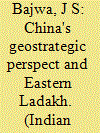

|
|
|
| 3 |
ID:
184177
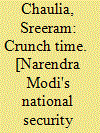

|
|
|
|
|
| Publication |
New Delhi, Rupa Publications India Pvt Ltd, 2022.
|
| Description |
lviii, 219p.hbk
|
| Standard Number |
9789355202567
|
|
|
|
|
|
|
|
|
|
|
|
Copies: C:1/I:0,R:0,Q:0
Circulation
| Accession# | Call# | Current Location | Status | Policy | Location |
| 060164 | 355.03/CHA 060164 | Main | On Shelf | General | |
|
|
|
|
| 4 |
ID:
155989
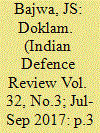

|
|
|
| 5 |
ID:
171228
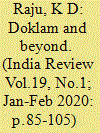

|
|
|
|
|
| Summary/Abstract |
Sovereignty over territory is the founding principle of international legal order and essential for the implementation of the sovereign rights of a State. Territorial disputes become commonplace among countries, mainly when bilateral agreements do not explicitly demarcate them. India and China are two Asian giants when it comes to population and economy. The recent cross-border tension between India and China has at its vortex the issue of the Doklam plateau region which shares borders with three countries namely India, Bhutan, and China and is popularly known as the “Tri-Junction.”
The present article re-visits the history of the Indo-China border dispute and tries to explain the legal aspects of border disputes under international law. It closely analyzes the principles applicable to these disputes and the decisions of various international institutions that are relevant. Furthermore, the article examines bilateral agreements to understand the possible violations and consequences under international law. It is argued that the peaceful co-existence between India and China must be of paramount importance to ensure Asian security and well-being. Keywords: India, China, Bhutan, Doklam, Territorial Disputes.
|
|
|
|
|
|
|
|
|
|
|
|
|
|
|
|
| 6 |
ID:
157623
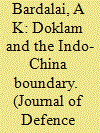

|
|
|
|
|
| Summary/Abstract |
On 19 December 2017, three days ahead of the scheduled 20th Round of Indo-China border talk between the Indian National Security Advisor (NSA), Ajit Doval, and China’s State Councillor, Yang Jiechi (the details of which are yet to be made public), the daily Times of India reported a statement by China that the Doklam standoff posed a ‘major test’ for the bilateral ties and that lessons should be learnt from it to avoid a similar situation of its kind in the future.1 China’s statement was made in the context of the face-off between Indian Army and China’s People’s Liberation Army (PLA) in the Doklam plateau (see Figure 1), a disputed area of 89 sq km in western Bhutan, near East Sikkim. The crisis occurred on 8 June 2017, when PLA troops crossed over to the Bhutanese territory with road construction machinery, with the aim of building a motorable road connecting Chumbi Valley and the Doklam Plateau. In response, the Indian Army from the nearby Sikkim garrison quickly moved inside the Bhutanese territory and prevented the PLA from constructing the road. The standoff continued till 28 August when both the countries agreed to pull back their troops with the media hailing it as a diplomatic victory.
|
|
|
|
|
|
|
|
|
|
|
|
|
|
|
|
| 7 |
ID:
164444
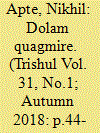

|
|
|
| 8 |
ID:
156050


|
|
|
| 9 |
ID:
162695
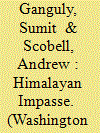

|
|
|
|
|
| Summary/Abstract |
In mid-June 2017, Bhutanese authorities detected Chinese personnel, presumably members of the People’s Liberation Army (PLA), building a road in a disputed region of the Doklam plateau near the Bhutan-China-India tri-junction. Lacking the military wherewithal to prevent the activity underway, Bhutan turned to India for assistance.1
1 Vidhi Doshi and Simon Denyer, “China Pushes Hard in Border Dispute with India,” Washington Post, July 6, 2017, https://www.washingtonpost.com/world/asia_pacific/china-pushes-hard-in-border-dispute-with-india/2017/07/06/52adc41e-619b-11e7-80a2-8c226031ac3f_story.html?noredirect=on&utm_term=.0e4267c15214.
View all notes
Within days, Indian Army units were deployed to the area to halt the road construction. Over the next month or so, Indian and Chinese military units became involved in a close confrontation with neither side displaying any interest in standing down. Eventually, the Chinese stopped their activity toward the end of August but did not abandon their claims to the disputed areas.
|
|
|
|
|
|
|
|
|
|
|
|
|
|
|
|
| 10 |
ID:
175388
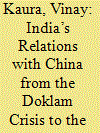

|
|
|
|
|
| Summary/Abstract |
No other bilateral relationship for India is as complex and challenging as the one with China. The intractable border dispute is at the root of their rivalry. The military stand-off at Doklam in 2017 had poisoned the bilateral relationship until steps were taken to remove mistrust and misunderstanding through two ‘informal’ summits between Prime Minister Narendra Modi and President Xi Jinping in 2018 and 2019. Nonetheless, the sense of general improvement in Sino-Indian ties generated at Wuhan and Mamallapuram was shattered by China’s aggressive behaviour in June 2020 at the Galwan Valley in Ladakh along the Line of Actual Control (LAC). The article traces key events during the Doklam stand-off and the violent military clashes at Galwan, as well as the steps taken by India to enhance political trust at the highest level. It contends that since there has been no change in China’s policies on a range of issues that are critical for India, it is not possible for India to remain ambivalent on how to deal with China. The article concludes that there seems to be greater recognition of the challenge from China and the need to recalibrate the Indian response.
|
|
|
|
|
|
|
|
|
|
|
|
|
|
|
|
| 11 |
ID:
159535
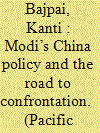

|
|
|
|
|
| Summary/Abstract |
The Doklam confrontation between India and China in the summer of 2017 was symbolic of the brewing tensions in their relationship. While the confrontation was resolved peacefully, its roots go back at least to 2007. Both the Manmohan Singh government and the Narendra Modi government pushed back against what they perceived to be a series of moves on bilateral, regional, and international issues that went against Indian interests. Modi’s responses have been more aggressive than Manmohan Singh’s in two ways. First, under Modi, India has more openly than ever before attempted to construct a coalition of militarily powerful states in the Asia-Pacific to increase Delhi’s bargaining power with Beijing. Second, India has sought to change the terms of engagement on the border conflict in three respects: a return to clarification of the Line of Actual Control (LAC) as the first step in border negotiations; linking further normalization between the two countries to progress towards a final border settlement; and seeking to inject a greater sense of urgency in the search for a settlement. This article concludes by asking why Modi responded more aggressively to China. It presents four explanations and concludes that Modi’s election in May 2014 coincided with a growing sense of strategic exasperation in India over its China policy, which questioned the value of the post-1988 commitment to normalization. The paper suggests that Modi shared that sense of exasperation, hence the rapid change in India’s stance within months of his coming to power.
|
|
|
|
|
|
|
|
|
|
|
|
|
|
|
|
| 12 |
ID:
170897
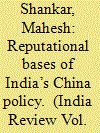

|
|
|
|
|
| Summary/Abstract |
This paper analyzes instances of the Indian leadership’s choice of an escalatory approach in its border dispute with China, first in the adoption of the Forward Policy in the lead up to the 1962 war, and more briefly the more recent decision in 2017 to take escalatory action in response to Chinese activity in the Doklam area in the trijunction of the India-China-Bhutan border region. In doing so, the paper demonstrates how a focus on reputation as an explanatory factor may allow us to make better sense of how Indian leaders have in the past and continue to in the present make decisions on key issues of national security concern.
|
|
|
|
|
|
|
|
|
|
|
|
|
|
|
|
| 13 |
ID:
156110
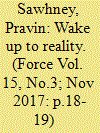

|
|
|